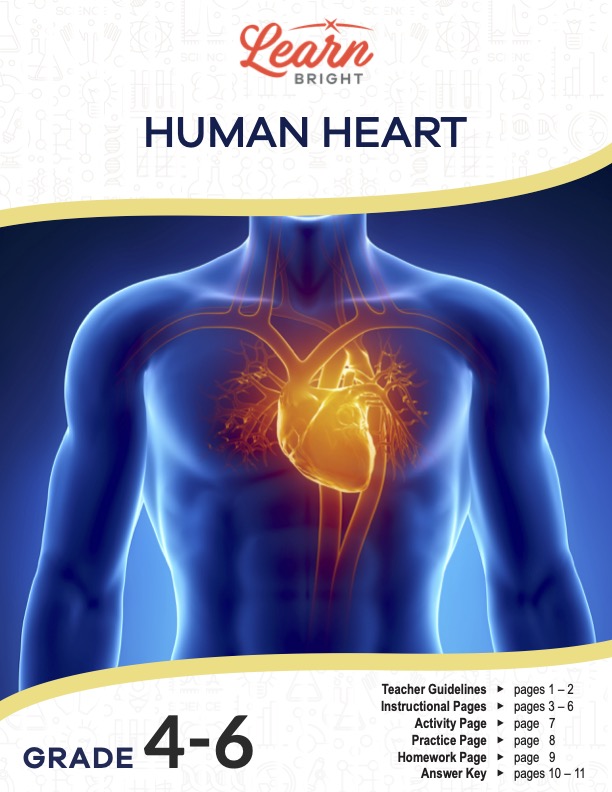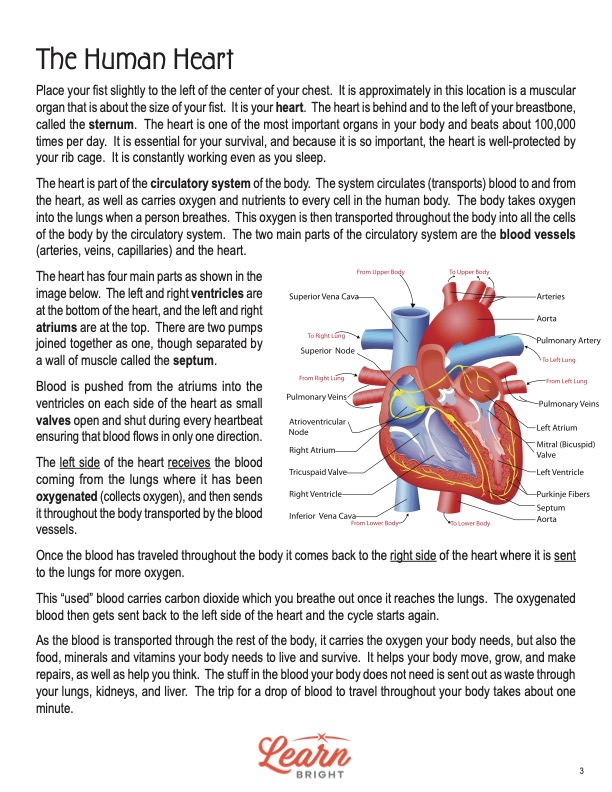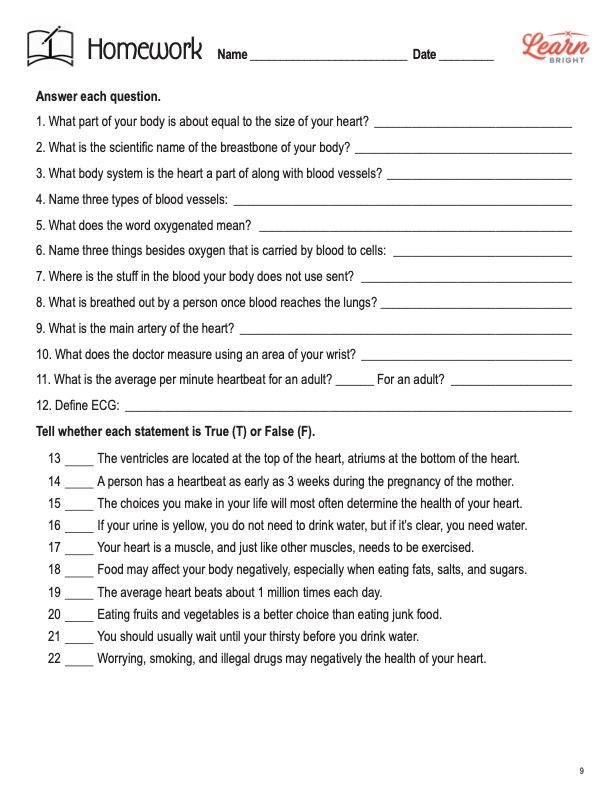Description
What our Human Heart lesson plan includes
Lesson Objectives and Overview: Human Heart teaches students about the importance and functions of this vital organ. Students will learn about the heart’s role as part of the circulatory system of the human body. They will discover the different parts of the heart and their unique functions. In addition, they will learn ways that they can help keep their hearts healthy. This lesson is for students in 4th grade, 5th grade, and 6th grade.
Classroom Procedure
Every lesson plan provides you with a classroom procedure page that outlines a step-by-step guide to follow. You do not have to follow the guide exactly. The guide helps you organize the lesson and details when to hand out worksheets. It also lists information in the yellow box that you might find useful. You will find the lesson objectives, state standards, and number of class sessions the lesson should take to complete in this area. In addition, it describes the supplies you will need as well as what and how you need to prepare beforehand. This lesson requires colored pencils or markers, construction paper or poster boards, and scratch paper.
Options for Lesson
The “Options for Lesson” section of the classroom procedure page provides a number of suggestions for additional activities and tasks or alternate ways to go about aspects of the lesson. For the Human Heart lesson plan, a few of these relate specifically to the activity worksheet. Students could work in pairs or groups instead of alone, for example. You may also have them create both posters instead of just one or the other. Another option is to plan a “Heart Health Day” during which students demonstrate healthy exercises or bring in healthy foods. You could invite speakers from the medical profession to talk to the class as well. Another suggestion is to assign students another living organism that has a heart and have them research how it works. They can later present what they find to the class. You could also have students research various heart diseases and how to prevent them. A final option is to plan an activity that involves measuring active and resting pulses.
Teacher Notes
The paragraph on the teacher notes page provides a little extra information or guidance as you prepare for the lesson. It suggests teaching this lesson in conjunction with one on the circulatory system. The blank lines on this page are available for you to write down any other thoughts you have regarding the lesson before giving it to your students.
HUMAN HEART LESSON PLAN CONTENT PAGES
Parts of the Heart
The Human Heart lesson plan contains four content pages. The first page describes where to find the heart within the body and explains its role in the circulatory system. The heart is behind and to the left of the breastbone, or sternum. About the size of a fist, it is one of the most important organs in the body and is essential to survival. The rib cage protects the heart like a shield because it is so important.
The heart beats around 100,000 times a day and works even when we sleep. It is part of the circulatory system, which circulates or transports blood to and from the heart and carries oxygen and nutrients to every cell in the body. Our bodies take oxygen into the lungs when we breathe, and then the components of the circulatory system transport the oxygen throughout the body. The two main parts of the circulatory system are blood vessels (which include arteries, veins, and capillaries) and the heart.
The heart has four major parts: left ventricle, right ventricle, left atrium, and right atrium. The left and right ventricles are near the bottom of the heart while the left and right atriums are at the top. There are also two pumps that join together as one and separated only by a wall of muscle called the septum. Blood is pushed from the atriums and into the ventricles on each side of the heart as small valves open and shut. This happens during every heartbeat to ensure the blood flows in only one direction.
Blood Flow of the Human Heart
To maintain this one-directional flow, the left side of the heart receives oxygenated blood coming from the lungs. (This is blood that has collected oxygen.) It then sends the blood throughout the body through various blood vessels. Once the blood travels around the body, it returns to the right side of the heart. Then the heart sends the blood toward the lungs for more oxygen.
The lesson explains how this “used” blood carries carbon dioxide. We breathe the carbon dioxide out once it reaches our lungs again. The lungs once again oxygenate the blood that then goes back to the left side of the heart. The whole cycle repeats again and again every time we breathe in and out.
The blood that vessels transport through the rest of the body carries more than just the oxygen that our bodies need. It also carries the food, minerals, and vitamins we need to live and survive. This whole process helps the body move, grow, repair itself, and even think. There is also stuff within the blood that we do not need. The body discards these substances as waste through the lungs, kidneys, and liver. It takes about one minute for a drop of blood to travel completely around the body.
Heartbeats
Students will next learn about heartbeats. A heartbeat happen when the heart pumps blood to the body and the arteries contract. The main artery through which a heart pumps blood through the rest of the body is the aorta. Like all arteries, its muscular walls are what pumps the blood. Heartbeats result when the arteries expand as they fill with blood and then contract when the heart relaxes. This rhythm between the heart and arteries is also called a pulse.
The rate of a heartbeat varies among people for a number of reasons, including age. On average, a child’s pulse is about 90 beats per minute while an adult’s pulse is around 70 beats per minute. Another variable that can change that number is a person’s need for oxygen. If the body needs more oxygen, the heart will beat faster, which is why the heart rate increases when running. When someone sits still, rests, or sleeps, their heart beats slower because they don’t need as much oxygen.
Doctors or other medical professionals use a machine called an electrocardiogram (ECG) to measure a person’s heartbeat. An ECG measures the electrical impulses that occur during every heartbeat. In fact, it can detect the first heartbeats of a fetus just three weeks into a pregnancy. Medical personnel use the information they receive from an ECG to help people remain healthy.
Keep the Heart Healthy
The body is complex, very similar to a machine with lots of moving parts and pieces. Like every machine, it needs regular maintenance and repairs when necessary, as well as fuel or energy of some kind to work properly. A car has an engine, for instance, that is much like the heart. It is responsible for many functions, and a car will not run efficiently or even at all if the engine doesn’t work.
The lesson provides a list of four specific things students can do to keep their hearts healthy. Exercise is the first. While the heart is an organ, it is made up of a lot of muscle. As such, we need to exercise it to keep it strong. Ways to incorporate more exercise include walking instead of driving places, playing active games outdoors, or joining a sport.
Eating healthy is another way to ensure the heart remains in good shape. Food affects the heart either positively or negatively, depending on what the food contains. Fatty foods can block arteries and force the heart to work harder to pump blood because there isn’t as much space for it to flow. The lesson suggests eating fruits and vegetables rather than junk food or avoiding foods that have lots of sugar or oil. Similarly, drinking enough water helps the heart more easily pump blood through the body. Students will learn that if they ever feel thirsty, then they are already dehydrated. They should drink water throughout the day and avoid getting to the point where they feel thirsty.
The last suggestion is to simply move. It can be very easy to remain still for long periods of time, such as sitting in the same spot while watching TV or reading. The lack of movement is not good for the heart. Instead, the lesson chart suggests taking breaks during long periods of sitting down to get up and move around. Taking a short walk, even for just a few minutes, will help the heart remain healthy.
How Bad Choices Affect the Human Heart
Students will discover that their daily choices are the ones that will most often determine how healthy their heart is. They could ask themselves if one choice outweighs another in terms of staying healthy: Should I eat a banana or a chocolate bar? Should I play a game outside or stay in and watch a movie? Should I sprinkle extra salt on this food or eat it without?
For the most part, no one forces people to eat junk food or sit all day long. It is very often a choice, usually made out of habit. The lesson explains to students that it could be tempting later in life to smoke cigarettes or use illegal drugs. As they grow older, students will face choices that relate to food, drugs, alcohol, smoking, and so on. They have to decide whether to value their health more than the short-term pleasure they may receive from alternative choices.
It may surprise students to learn that much evidence suggests that stress, sadness, worry, and similar factors can sometimes affect the heart. You can emphasize to students that if something is causing them to feel those things, holding it in and trying to deal with the problem alone may not be good for their heart. As an example, when a student doesn’t finish their homework and starts to worry about it, their heart beats faster. Their heart actually starts to overwork because of stress and worry.
HUMAN HEART LESSON PLAN WORKSHEETS
The Human Heart lesson plan includes three worksheets: an activity worksheet, a practice worksheet, and a homework assignment. Each one will help students solidify their grasp of the concepts and information they learned throughout the lesson. The guidelines on the classroom procedure page outline when to hand out each worksheet to the class.
HEART POSTER ACTIVITY WORKSHEET
For the activity, students will create a poster about the heart. They can either make one that shows how blood moves through the heart and to the body or one that shows how a person can maintain a healthy heart. If they choose the poster about blood movement, they must include and label the parts of the heart. They must also explain how blood travels throughout the body and back to the heart. In addition, they will need to include designs or images to help the viewer understand, such as arrows to display the direction of the movement. If students choose the poster about keeping the heart healthy, they should include suggestions or ideas for how to accomplish this. They will also need images and well-explained strategies to encourage people to make heart-healthy choices. The posters need to be creative and interesting. Students can use scratch paper to create a rough draft of the poster before drawing the final draft onto the poster. You can use the rubric at the end of the worksheet to grade students’ finished products.
LABEL AND ORDER PRACTICE WORKSHEET
The practice worksheet has two sections. The first section requires students to label seven parts of the heart using the terms in a word bank. For the second section, students must place the steps of blood movement in the correct order. The worksheet provides the first step.
HUMAN HEART HOMEWORK ASSIGNMENT
Like the practice worksheet, the homework assignment includes two sections. The first section requires students to answer 12 prompts. For the second section, students will read 10 statements and decide whether they are true (T) or false (F). You may or may not allow students to use the content pages for reference.
Worksheet Answer Keys
The last two pages of the lesson document are answer keys for the practice and homework worksheets. The answers are in red to make it easy to compare to students’ work. There may be some variation in students’ responses to a few of the questions because they require more than one-word answers. Keep that in mind as you grade, and ensure students’ answers are correct even if they are different. If you choose to administer the lesson pages to your students via PDF, you will need to save a new file that omits these pages. Otherwise, you can simply print out the applicable pages and keep these as reference for yourself when grading assignments.










